Navigating the regulatory landscape of nutrition labeling in Canada is a crucial task for anyone involved in the food industry. Health Canada has released strict guidelines when it comes to nutrition facts labels so consumers can have accurate and informative information on what they are choosing to consume every day.
Manufacturers and retailers need to ensure their products have accurate and compliant labels, and that they use the correct templates for their specific food packages. This not only helps by fostering trust and transparency with consumers but is also a legal requirement. Leveraging sophisticated software can significantly simplify this process, making it easier to meet compliance standards while maintaining operational efficiency.
TLDR
- Canadian Nutrition Templates Overview: Choosing the correct label is key to ensuring compliance with Canadian labeling requirements.
- Standard Format: Most commonly used for packaged foods, featuring a clear layout for easy reading.
- Narrow Standard Format: Ideal for smaller packages with limited space, retaining all required nutritional details in a narrow layout.
- Bilingual Standard Format: Necessary for products in bilingual regions, providing nutritional information in both English and French.
- Bilingual Horizontal Format: Best for wider packages, displaying information horizontally to fit items like beverage cans.
- Simplified Standard Format: Used for small packages, including only crucial nutritional information due to space constraints.
- Bilingual Simplified Standard Format: A space-efficient format for small packages requiring bilingual labels, showing only essential information.
- Bilingual Simplified Horizontal Format: Designed for small, wide packages that need bilingual labels; arranges information horizontally.
- Dual Format: Displays nutritional information for both prepared and unprepared states of foods that require preparation.
- Aggregate Format: Suitable for packages with multiple food items, listing nutrition facts separately for each component.
- Linear Format: Fits narrow or vertically long packages, organizing information in a streamlined, linear layout.
- Food Label Maker simplifies the compliance process, ensuring up-to-date labels that meet CFIA regulations and adapting to various template needs.
Canadian Nutrition Templates
Understanding the various types of nutrition label templates available is key to ensuring that your food products meet the specific labeling requirements mandated in Canada. Let’s explore the different templates and their appropriate uses to help you select the most suitable option for your products.
Standard Format
This is the label format that is the most used for packaged food products. It has a simple and effective layout that makes it easy for consumers to quickly read and understand.
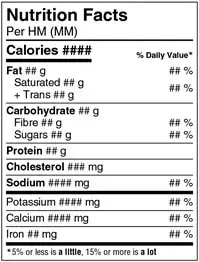
Narrow Standard Format
The narrow standard format is used for packages with limited space and not enough to display a standard format label. This template is narrower than the standard version but still depicts the essential elements required by Canadian regulations, so it is ideal for smaller packages.
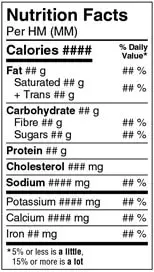
Bilingual Standard Format
The Bilingual Standard Format is used for products that are sold in regions where both English and French are spoken and used on product packaging. This template also ensures that all nutritional information is available in Canada’s two official languages. This adds to the linguistic diversity of Canadian consumers and so that French-speaking individuals can clearly read a food label.
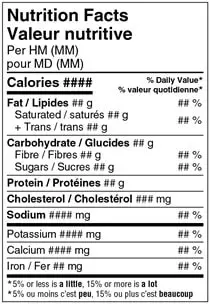
Bilingual Horizontal Format
The Horizontal Format is tailored for products with wider packaging. This layout displays nutritional information in a horizontal direction so that it’s easier to fit on products like beverage cans or elongated packages.

Simplified Standard Format
Smaller packages, which cannot accommodate the full standard label due to space limitations, can benefit from the Simplified Format. This version includes only the most crucial nutritional information, ensuring compliance without overwhelming the available space.
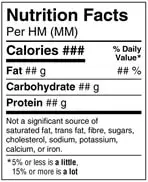
Bilingual Simplified Standard Format
The Bilingual Simplified Standard Format is exactly what it sounds like, a simplified label showing only the most essential nutritional information but in both English and French. It combines the needs for bilingual labeling and space efficiency for smaller packages.
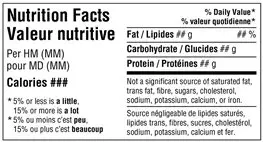
Bilingual Simplified Horizontal Format
The Bilingual Simplified Horizontal Format is designed for small and wide packages that are bilingual. This format arranges essential nutritional information horizontally so that it fits comfortably on products with limited vertical space but more horizontal space. It is perfect for items like snack bars or small boxed foods, making it both space-efficient and reader-friendly.
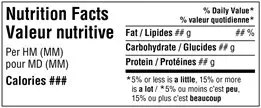
Dual Format
The Dual Format is particularly useful for foods that require some form of preparation, like cake mixes or pasta. It shows nutritional information for both the prepared and unprepared versions of the food, so this is a far more details presentation for consumers.
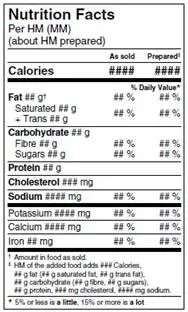
Aggregate Format
Ideal for packages containing assortments of different foods, such as variety packs, the Aggregate Format lists the nutrition facts for each component separately. This format is helpful for clarity and detail so that consumers can understand the nutritional content of each item within the package.
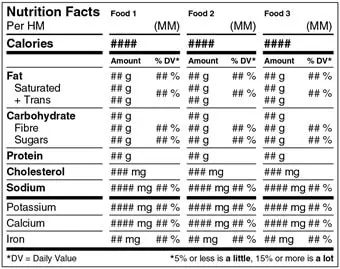
Linear Format
The Linear Format is ideal for narrow or vertically long packages. This streamlined format arranges the nutritional information in a linear fashion, making it ideal for products such as spice jars or stick packs.

Each of these templates is designed to cater to specific packaging and informational needs, ensuring that all products sold in the Canadian market can comply with nutritional labeling regulations efficiently. By utilizing the right nutrition facts template, manufacturers can enhance the accuracy and compliance of product labels and foster consumer trust.
See How FoodLabelMaker Can Help You
Which Format Should You Use?
Deciding on the appropriate nutrition facts table for your product packaging can be streamlined using a decision-tree approach. Download this pdf for a simplified guide to help you select the right format.
Easy Compliance
Food Label Maker (FLM) simplifies the compliance process for nutrition labeling in Canada. Their platform is designed with the latest regulatory standards in mind, offering a range of templates from Standard to Aggregate formats that automatically adjust to fit your product’s specific requirements. FLM’s easy-to-use interface allows you to put in your product’s nutritional data and select the appropriate template with ease.
Additionally, FLM ensures that your labels are always up-to-date with the latest food CFIA labeling regulations so that you are not as risk of non-compliance. With FLM, you can trust that your product labels are accurate, compliant, and customized to meet the demands of Canadian consumers.
FAQS:
Who Needs to Comply?
All food manufacturers and distributors in Canada must comply with nutrition labeling regulations, except for a few specific exemptions such as very small businesses, fresh fruits and vegetables, and foods prepared and sold in restaurants.
What needs to be on a nutrition label in Canada?
A Canadian nutrition label must include the number of calories, and key nutrients such as fat, saturated and trans fats, cholesterol, sodium, carbohydrates, fiber, sugars, protein, and certain vitamins and minerals. It should also include the serving size and the daily value percentages of the nutrients.
What size are nutrition labels in Canada?
The size of nutrition labels in Canada depends on the package size and the format of the nutrition facts table used. There is no one-size-fits-all; each format is designed to fit different package sizes and shapes appropriately.
What font is used for nutrition facts in Canada?
The font used for nutrition facts in Canada must be legible, with a minimum type size requirement generally being 6 points. The font style of a nutrition facts table is usually Sans Serif Font, so Arial and Helvetica are acceptable. Ultimately, it must be clear and easy to read on food packages.



